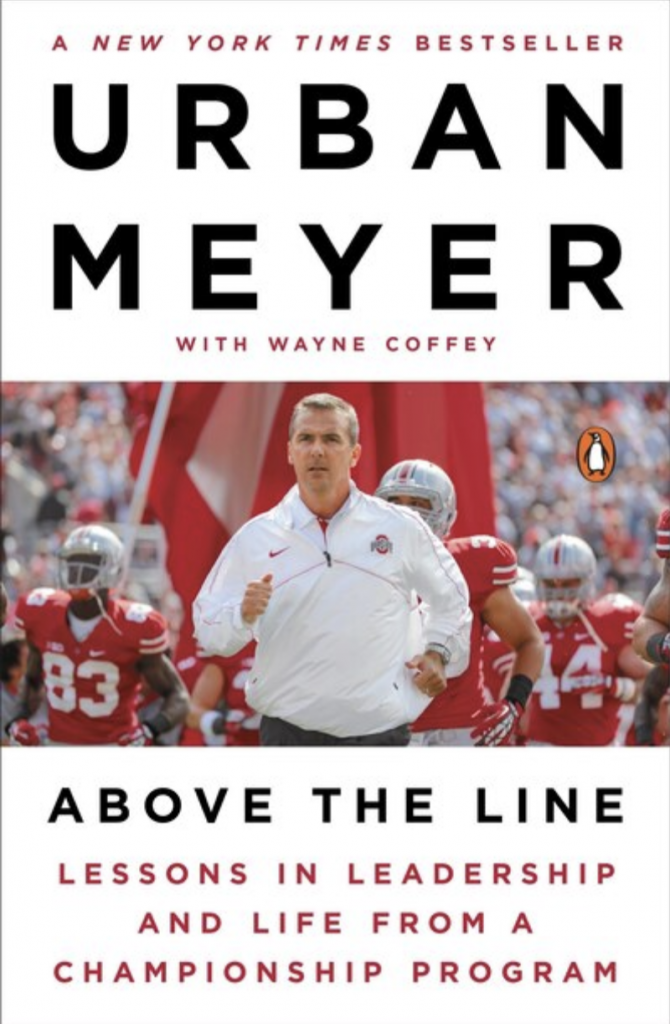Key Quote:
“Leaders create culture. Culture drives behavior. Behavior produces results” (p. 83). — Urban Meyer
Key Points:
Leading From the Heart. Leadership styles may vary, but effective leaders have a passion to “work to get better every day” even as they “savor the journey” (p. 22).
The Foundation. Every single day, choose to lead your team to work and train “Above The Line” – that is, train with purpose, intention, and skill. Steer clear of “Below the Line” behavior, which is the “blame, complain, defend” approach to life and work.
The R Factor. We cannot control events and have little control over outcomes. What we can control is the “R factor” – our response.
Creating Culture. Results are driven by leaders who understand and work to create an Above the Line culture and that culture will yield Above The Line behavior. “Every organization has a culture either by design or default” (p. 83).
Relentless Effort. “Success is cumulative and progressive. So is failure.” Meyer stresses the importance of pushing yourself to get better every single moment. “Relentless effort (not talent or intelligence) is the key to achieving great things in life” (p. 98).
Competitive Excellence. You must prepare well in practice in order to win the game. “You will play like you practice” (p. 119).
Power of the Unit. A team with strong connections that trusts each other will go the extra mile to win for their teammates, not just for their individual personal gain. “High levels of performance require deep levels of trust” (p. 144).
The Necessity of Alignment. Team alignment is integral to high-level performance. “In an aligned organization, every employee – from the executive suite to the loading dock – understands not only the strategies and goals of the business, but also how their individual contribution matters” (p. 147).
The 10-80-10 Principle. A good leader seeks to move the 80 percent of solid but uninspired performers into the performance mindset of the top ten percent. “Stop wasting time trying to motivate the bottom ten percent” (p. 184).
Think Like a Leader. Good leaders make the time and find the solitude to think deeply and creatively. Meyer states, “exceptional leaders think about common things in an uncommon way” (p. 199). And they listen to other people’s ideas.
The Power of Belief. Performance is profoundly affected by belief. Good leaders build their teams up with empowering messages, meaningful phrases, and reminders of values and connection, and all of these work together to urge people to excel. “The highest levels of performance are empowered by the deepest levels of belief” (p. 222).
The Chase Is Complete. “A leader is someone who inspires and empowers people to get to places that they wouldn’t be able to reach otherwise, sure, but you need to have people willing to be led” (p. 235).
Key Concepts:
“Above The Line” Versus “Below The Line” Culture
There are three steps to building a culture: 1) believe in the core values you want to instill, 2) communicate these values with clarity and consistency, and 3) hold individuals to the standards you have put in place (pp. 72-73).
Coach Meyer emphasizes that “Above The Line behavior is the foundation of success in anything you do.” Meyer describes it as “conscious and thoughtful – a choice made in alignment with your larger vision of where you want to go.”
To the contrary, “Below the Line behavior is directed by impulse or the gravitational pull of old habits; you just react without thinking” (p. 28).
“One of the biggest mistakes leaders make is failing to hold people accountable for behavior that is inconsistent with the culture. Remember this: if you permit it, you promote it” (pp. 73-74).
Meyer demonstrated his commitment to leadership at Ohio State by developing an in-depth, systematic leadership-training program that he conducted during the off-season. He invited speakers to hold workshops with his coaching staff and players and gave quizzes and skill-building exercises to build a culture that performs Above the Line (p. 8.).
Below the Line behavior consists of three traits: blame (others), complain (about circumstances), and defend (yourself) – or “BCD.” To be an effective leader, “ruthlessly eliminate BCD. Instead of accountability, BCD creates a culture of excuse-making and victimization – things that are toxic for your organization and performance” (p. 30).
Individuals can lead a life Above The Line by understanding that: Event (E) + Response (R) = Outcome (O). “We don’t control the events in life, and we don’t directly control the outcomes. But we always have control over how we choose to respond” (pp. 41-42).
There are six steps to successfully execute the R Factor (response): pause, focus your mind, step up, adjust and adapt, make a difference, and build skill (pp. 44-52).
Culture Trumps Strategy
“On a team driven by intentional culture, attitude and effort are focused in the same direction, and the foundation for success has been created.” Meyer explains, “This is culture by design” (p. 64).
“On a team with less-than-effective culture, players and coaches are not in alignment. Trust is weak. Communication and teamwork are poor. There is a lot of BCD.” Meyer explains, “This is culture by default” (p. 64).
“Culture eats strategy for lunch. Talent, schemes, tactics, and plans cannot replace a strong culture. A great culture can make even a mediocre strategy successful, but a weak culture will undermine even the best strategy. The foundation of culture is core beliefs.” Core beliefs are “the beliefs that are the heart of the team” (p. 66).
“You must guard against focusing so much on wins and losses that you don’t pour all the energy and clarity required to build a healthy culture. Yes, results are important,” Meyer explains, “But again, culture is what sustains the behavior that gets you those results” (p. 82).
Core Values: Effort, Excellence, and the Power of the Unit
“We believe that being elite is not about how talented you are. It is about how tough you are. To achieve anything great in life, you have to fight for it. Every day” (p. 89).
“Elite performance requires elite preparation” (p. 119).
“You will play like you practice. You can’t practice on autopilot and play with purpose. How you compete in practice will determine how you compete in games” (p. 119).
U.S. military battlefield experience research emphasizes the power of the unit. In general, soldiers hate combat because they fear death, they experience emotional stress, and they are reluctant to shoot another human being. “However, a person will fight for a guy in his unit. Tenaciously. For however long it takes” (p. 124).
Deep trust “creates an unbreakable bond among players and coaches. Trust takes the team to a level of performance that cannot be achieved without it. The strength of a team is determined by the strength of the connections on the team” (p. 126).
Trust is built on three levels: character (or “ethical trust”), competence (or “technical trust”), and connection (or “personal trust”) (p. 128).
Align, Motivate, and Believe
“In order to achieve elite performance, alignment is essential. When a team is aligned, everyone understands and is fully committed to the team’s purpose, culture, and strategy” (p. 147).
“An aligned organization gets things done faster and with better results and is more agile and responsive to the competitive environment” (p. 147).
To align individuals on a team, you must: “hire the right people and recruit the right players,” “communicate your purpose and your culture,” equip leaders to “build and maintain alignment,” and “hold everyone accountable” (pp. 149-150).
In business, there is a theory called the 10-80-10 principle: the top ten percent in a given company represent the elite performers, the 80 percent majority is loyal but stagnant, and the outer ten percent are underperforming and defiant. “The leadership challenge is to move as many of the 80 percenters into the nucleus as you can” (p. 162).
Leaders should inspire individuals to believe they can outperform their best performance. “Research shows that the highest levels of human performance are empowered by the deepest levels of belief” (p. 205).
Meyer empowered his team with a principle called “Six Percent.” He encouraged individuals every day to improve their mental and physical skills by just six percent. In doing so, they would be able to compete at an elite level by the time they faced difficult competitors (p. 210).
The Leadership Effect
“Leadership isn’t a difference maker. It is the difference maker” (p. 22).
“A leader is someone who earns trust, sets a clear standard, and then equips and inspires people to meet that standard” (p. 22).
“To me, the essence of life and leadership is change and growth. It is about pushing yourself to improve every day in whatever you do. I truly believe in the maxim that if you are not getting better, you are getting worse” (pp. 20-21).
“Here’s the great secret about leadership: it’s not about you. It’s about making other people better. Leadership is more about the trust you have earned than the authority you have been granted. You must earn the right for people to follow you” (p. 238).
Meyer, U. (2015) Above the Line: Lessons in Leadership and Life From a Championship Season: New York: Penguin Press.

“Leadership isn’t a difference maker. It is the difference maker.”
Here’s the great secret about leadership: it’s not about you. It’s about making other
people better.
